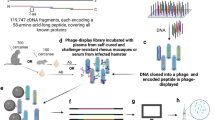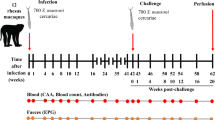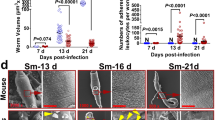Abstract
Schistosomes are blood-dwelling flukes that infect 200 million people worldwide and are responsible for hundreds of thousands of deaths annually1. Using a signal sequence trap, we cloned from Schistosoma mansoni two cDNAs, Sm-tsp-1 and Sm-tsp-2, encoding the tetraspanin (TSP) integral membrane proteins TSP-1 and TSP-2. We raised antibodies to recombinant TSP fusion proteins and showed that both proteins are exposed on the surface of S. mansoni. Recombinant TSP-2, but not TSP-1, is strongly recognized by IgG1 and IgG3 (but not IgE) from naturally resistant individuals but is not recognized by IgG from chronically infected or unexposed individuals. Vaccination of mice with the recombinant proteins followed by challenge infection with S. mansoni resulted in reductions of 57% and 64% (TSP-2) and 34% and 52% (TSP-1) for mean adult worm burdens and liver egg burdens, respectively, over two independent trials. Fecal egg counts were reduced by 65–69% in both test groups. TSP-2 in particular provided protection in excess of the 40% benchmark set by the World Health Organization for progression of schistosome vaccine antigens into clinical trials. When coupled with its selective recognition by naturally resistant people, TSP-2 seems to be an effective vaccine antigen against S. mansoni.
This is a preview of subscription content, access via your institution
Access options
Subscribe to this journal
Receive 12 print issues and online access
$209.00 per year
only $17.42 per issue
Buy this article
- Purchase on Springer Link
- Instant access to full article PDF
Prices may be subject to local taxes which are calculated during checkout


Similar content being viewed by others
References
World Health Organization. Prevention and control of schistosomiasis and soil-transmitted helminthiasis: report of a WHO expert committee (World Health Organization, Geneva, 2002).
King, C.H., Dickman, K. & Tisch, D.J. Reassessment of the cost of chronic helmintic infection: a meta-analysis of disability-related outcomes in endemic schistosomiasis. Lancet 365, 1561–1569 (2005).
Bergquist, N.R., Leonardo, L.R. & Mitchell, G.F. Vaccine-linked chemotherapy: can schistosomiasis control benefit from an integrated approach? Trends Parasitol. 21, 112–117 (2005).
Minard, P., Dean, D.A., Jacobson, R.H., Vannier, W.E. & Murrell, K.D. Immunization of mice with cobalt-60 irradiated Schistosoma mansoni cercariae. Am. J. Trop. Med. Hyg. 27, 76–86 (1978).
Stek, M.F., Minard, P., Dean, D.A. & Hall, J.E. Immunization of baboons with Schistosoma mansoni cercariae attenuated by gamma irradiation. Science 212, 1518–1520 (1981).
Bergquist, N.R. & Colley, D.G. Schistosomiasis vaccines: research to development. Parasitol. Today 14, 99–104 (1998).
Verjovski-Almeida, S. et al. Transcriptome analysis of the acoelomate human parasite Schistosoma mansoni. Nat. Genet. 35, 148–157 (2003).
El-Sayed, N.M., Bartholomeu, D., Ivens, A., Johnston, D.A. & LoVerde, P.T. Advances in schistosome genomics. Trends Parasitol. 20, 154–157 (2004).
Pearce, E.J. & MacDonald, A.S. The immunobiology of schistosomiasis. Nat. Rev. Immunol. 2, 499–511 (2002).
Jones, M.K., Gobert, G.N., Zhang, L., Sunderland, P. & McManus, D.P. The cytoskeleton and motor proteins of human schistosomes and their roles in surface maintenance and host-parasite interactions. Bioessays 26, 752–765 (2004).
Smyth, D. et al. Isolation of cDNAs encoding secreted and transmembrane proteins from Schistosoma mansoni by a signal sequence trap method. Infect. Immun. 71, 2548–2554 (2003).
Levy, S. & Shoham, T. The tetraspanin web modulates immune-signalling complexes. Nat. Rev. Immunol. 5, 136–148 (2005).
van Balkom, B.W. et al. Mass spectrometric analysis of the Schistosoma mansoni tegumental sub-proteome. J. Proteome Res. 4, 958–966 (2005).
Braschi, S. & Wilson, R.A. Proteins exposed at the adult schistosome surface revealed by biotinylation. Mol. Cell. Proteomics (2005).
Correa-Oliveira, R. et al. The human immune response to defined immunogens of Schistosoma mansoni: elevated antibody levels to paramyosin in stool-negative individuals from two endemic areas in Brazil. Trans. R. Soc. Trop. Med. Hyg. 83, 798–804 (1989).
Correa-Oliveira, R., Caldas, I.R. & Gazzinelli, G. Natural versus drug-induced resistance in Schistosoma mansoni infection. Parasitol. Today 16, 397–399 (2000).
Viana, I.R. et al. Comparison of antibody isotype responses to Schistosoma mansoni antigens by infected and putative resistant individuals living in an endemic area. Parasite Immunol. 17, 297–304 (1995).
Viana, I.R. et al. Interferon-gamma production by peripheral blood mononuclear cells from residents of an area endemic for Schistosoma mansoni. Trans. R. Soc. Trop. Med. Hyg. 88, 466–470 (1994).
Hoffmann, K.F., Wynn, T.A. & Dunne, D.W. Cytokine-mediated host responses during schistosome infections; walking the fine line between immunological control and immunopathology. Adv. Parasitol. 52, 265–307 (2002).
Ribeiro de Jesus, A. et al. Human immune responses to Schistosoma mansoni vaccine candidate antigens. Infect. Immun. 68, 2797–2803 (2000).
Al-Sherbiny, M. et al. In vitro cellular and humoral responses to Schistosoma mansoni vaccine candidate antigens. Acta Trop. 88, 117–130 (2003).
Brito, C.F., Caldas, I.R., Coura Filho, P., Correa-Oliveira, R. & Oliveira, S.C. CD4+ T cells of schistosomiasis naturally resistant individuals living in an endemic area produce interferon-gamma and tumour necrosis factor-alpha in response to the recombinant 14KDA Schistosoma mansoni fatty acid-binding protein. Scand. J. Immunol. 51, 595–601 (2000).
James, S.L. & Sher, A. Mechanisms of protective immunity against Schistosoma mansoni infection in mice vaccinated with irradiated cercariae III. Identification of a mouse strain, P/N, that fails to respond to vaccination. Parasite Immunol. 5, 567–575 (1983).
James, S.L., Labine, M. & Sher, A. Mechanisms of protective immunity against Schistosoma mansoni infection in mice vaccinated with irradiated cercariae. I. Analysis of antibody and T-lymphocyte responses in mouse strains developing differing levels of immunity. Cell. Immunol. 65, 75–83 (1981).
Lewis, F.A. & Wilson, E.M. Strain differences in lymphocyte responses and in vitro suppressor cell induction between Schistosoma mansoni-infected C57BL/6 and CBA mice. Infect. Immun. 32, 260–267 (1981).
Williams, G.M. et al. Mathematical modelling of schistosomiasis japonica: comparison of control strategies in the People's Republic of China. Acta Trop. 82, 253–262 (2002).
Harn, D.A., Mitsuyama, M., Huguenel, E.D. & David, J.R. Schistosoma mansoni: detection by monoclonal antibody of a 22,000-dalton surface membrane antigen which may be blocked by host molecules on lung stage parasites. J. Immunol. 135, 2115–2120 (1985).
Sher, A., Hall, B.F. & Vadas, M.A. Acquisition of murine major histocompatibility complex gene products by schistosomula of Schistosoma mansoni. J. Exp. Med. 148, 46–57 (1978).
Loukas, A., Jones, M.K., King, L.T., Brindley, P.J. & McManus, D.P. Receptor for Fc on the surfaces of schistosomes. Infect. Immun. 69, 3646–3651 (2001).
Silva, E.E., Clarke, M.W. & Podesta, R.B. Characterization of a C3 receptor on the envelope of Schistosoma mansoni. J. Immunol. 151, 7057–7066 (1993).
Bethony, J. et al. Exposure to Schistosoma mansoni infection in a rural area in Brazil. III: Household aggregation of water-contact behaviour. Trop. Med. Int. Health 9, 381–389 (2004).
Bethony, J. et al. Exposure to Schistosoma mansoni infection in a rural area in Brazil. II: Household risk factors. Trop. Med. Int. Health 6, 136–145 (2001).
Gazzinelli, A. et al. Exposure to Schistosoma mansoni infection in a rural area of Brazil. I: Water contact. Trop. Med. Int. Health 6, 126–135 (2001).
Kloos, H., Passos, L.K., Loverde, P., Oliveira, R.C. & Gazzinelli, A. Distribution and Schistosoma mansoni infection of Biomphalaria glabrata in different habitats in a rural area in the Jequitinhonha Valley, Minas Gerais, Brazil: environmental and epidemiological aspects. Mem. Inst. Oswaldo Cruz 99, 673–681 (2004).
Kloos, H. et al. Combined methods for the study of water contact behavior in a rural schistosomiasis-endemic area in Brazil. Acta Trop. 97, 31–41 (2006).
Bethony, J. et al. Familial resemblance in humoral immune response to defined and crude Schistosoma mansoni antigens in an endemic area in Brazil. J. Infect. Dis. 180, 1665–1673 (1999).
Bethony, J. et al. Additive host genetic factors influence fecal egg excretion rates during Schistosoma mansoni infection in a rural area in Brazil. Am. J. Trop. Med. Hyg. 67, 336–343 (2002).
Harn, D.A., Mitsuyama, M. & David, J.R. Schistosoma mansoni: anti-egg monoclonal antibodies protect against cercarial challenge in vivo. J. Exp. Med. 159, 1371–1387 (1984).
Acknowledgements
We thank M. Smout for assistance with figure preparations, W. Schroeder for technical assistance and D. Diemert and P. Hotez for comments on the manuscript and discussions. This work was supported by grants from the National Health and Medical Research Council of Australia (NHMRC) and The Wellcome Trust. A.L. is the recipi of an R. Douglas Wright Career Development Award from NHMRC. M.S.P. was supported by an Australian Postgraduate Award. J.M.B. is supported by an International Research Scientist Award from Fogarty International Center, US National Institutes of Health.
Author information
Authors and Affiliations
Corresponding author
Ethics declarations
Competing interests
The authors declare no competing financial interests.
Supplementary information
Supplementary Table 1
Identification of cohorts of Chronically Infected (CI) and Putatively Resistant (PR) individuals in the S. mansoni endemic area of Siquiera (n = 162). (PDF 59 kb)
Supplementary Table 2
Inclusion and exclusion rules for the assembly and maintenance of resistant cohorts. (PDF 69 kb)
Rights and permissions
About this article
Cite this article
Tran, M., Pearson, M., Bethony, J. et al. Tetraspanins on the surface of Schistosoma mansoni are protective antigens against schistosomiasis. Nat Med 12, 835–840 (2006). https://doi.org/10.1038/nm1430
Received:
Accepted:
Published:
Issue Date:
DOI: https://doi.org/10.1038/nm1430
This article is cited by
-
Evolution of tetraspanin antigens in the zoonotic Asian blood fluke Schistosoma japonicum
Parasites & Vectors (2023)
-
Salmonella Typhimurium expressing chromosomally integrated Schistosoma mansoni Cathepsin B protects against schistosomiasis in mice
npj Vaccines (2023)
-
Comparative proteome analysis of the tegument of male and female adult Schistosoma mansoni
Scientific Reports (2022)
-
Antischistosomal effects of Ficus carica leaves extract and/or PZQ on Schistosoma mansoni infected mice
Journal of Parasitic Diseases (2022)
-
Spatial expression pattern of serine proteases in the blood fluke Schistosoma mansoni determined by fluorescence RNA in situ hybridization
Parasites & Vectors (2021)



